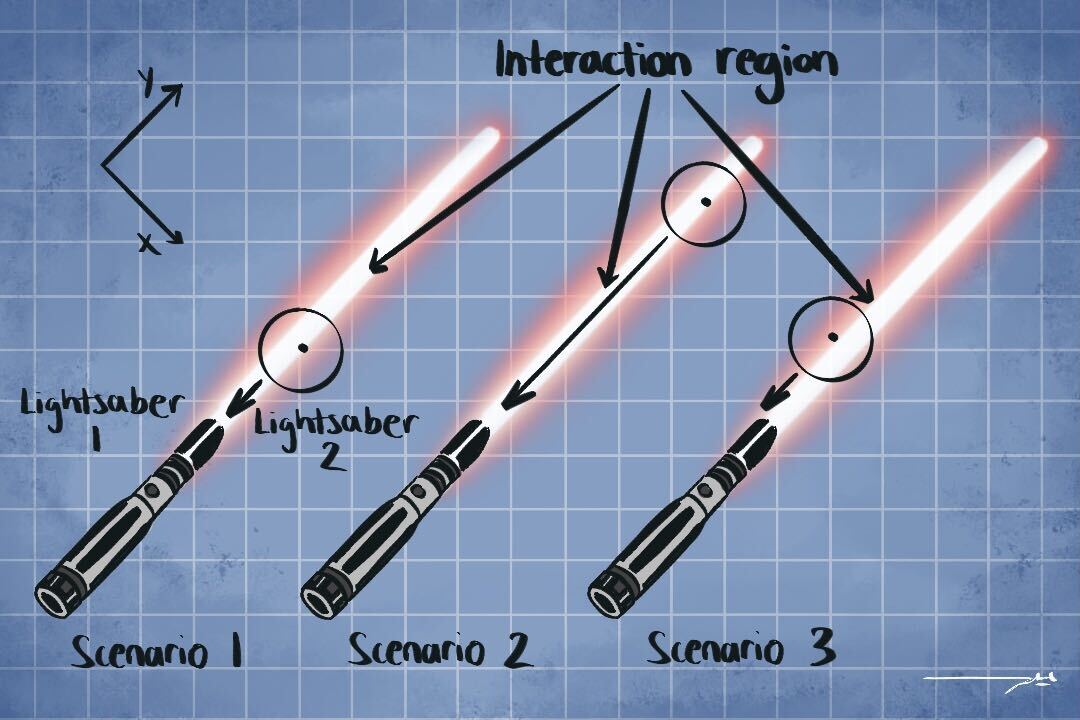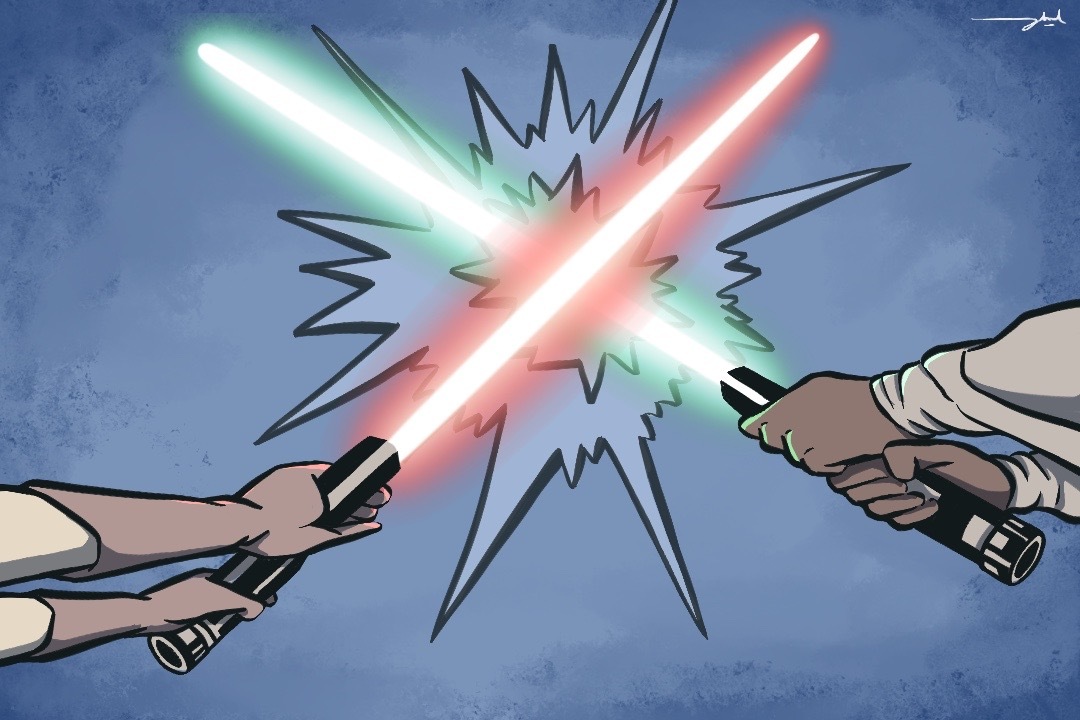Since its first appearance in the 1977 film Star Wars: Episode IV – A New Hope, the lightsaber has been a pop culture icon.
For the uninitiated, a lightsaber is a fictional sword-like energy weapon mainly used by members of the Jedi Order and the Sith — two warring factions of the “Force-sensitives” in the Star Wars universe. Force-sensitives are beings connected to the fictional energy field known as the “Force,” which grants extraordinary abilities to those capable of wielding it. The most pertinent of those abilities to us is building a lightsaber.
The Star Wars lightsaber
Star Wars lore outlines several key components a lightsaber needs to function. Sources differ on the subtleties of this, but, in general, a power cell — like a battery — is used in conjunction with a “kyber crystal” to power the lightsaber. This crystal is also the source of each lightsaber’s iconic colours. The lightsaber’s blade is made of plasma, which is a form of superheated matter that contains a lot of energy.
The blade is emitted when the power cell releases its plasma bolt, which is sent through a series of focusing lenses to the kyber crystal, which amplifies the energy being coursed through it via the Force. The energy emitted from the kyber crystal then passes through a blade emitter, which converts the raw energy into a plasma blade. Finally, this blade is surrounded by a magnetic stabilizing ring, which acts as the energy’s containment field — think of it as a glass case. These components of the lightsaber are contained within the hilt.
In Star Wars, a correctly constructed lightsaber can cut through virtually everything and deflect blaster bolts — projectiles that are the primary form of small-arms fire in the Star Wars universe. But this raises the question: is any of this possible in real life?
Sadly, if lightsabers are possible, we are far from achieving anything remotely similar. This is due to several physical constraints — outlined by researchers François Fillion-Gourdeau and Jean-Sébastien Gagnon in a 2019 paper — regarding the properties of light and the energy required to power a lightsaber.
Light is continuous and non-solid
Light is made up of elementary particles known as photons — essentially, light carriers. These photons are almost impossible to keep contained in the manner shown by a lightsaber’s containment field.
Think of photons in terms of sunlight. Every ray of sunlight that reaches Earth is made up of photons, all of which travel through space until they impact a surface. Getting a hypothetical lightsaber to only emit photons that travel within the specific length and width of the blade — and not beyond that — would be difficult, if not outright impossible.
In combat, two similar hypothetical light blades can have virtually infinite possible positions relative to each other, all of which would cause a unique physical interaction between the photons.
When two identical hypothetical light blades are crossed at each other’s exact centres, a likely position in combat, they would emit the same amount of photons, exerting an equal physical force on one another in opposite directions. As such, the force from the photons emitted from each blade would cancel out, resulting in no net force.
The closest light blades get to acting solid
Besides the respective center positions, in the vast majority of the positions between two light blades, one light blade will emit more photons that do not get canceled out. These undeterred photons will keep moving in a straight line until something stops their motion. In this case, these photons’ remaining resultant energy will cause the other light blade to experience a torque moment.
A torque moment is a rotational or twisting force. The photons which are emitted from one light blade are not actually rotating. Instead, they exert a linear force that translates into a rotational force on the hilt of the other light blade. This happens in the same way a car crashing into the rear of a perpendicular car will cause the other car to spin. This torque moment happens because the photons of the light blade which emits the most non-nullified photons are pushing the hilt of the other light blade.
The following figure demonstrates this motion in three of the many different scenarios of interaction between lightsaber 1 and lightsaber 2 where they are not crossing each other at their respective centers. In this figure, lightsaber 2 is perpendicular to you, the viewer.

The torque moment — which will be felt in the wrist of the wielder — is the closest the blades will get to having a solid interaction. This torque moment will not result from an exact-centre interaction between the light blades, as described above, because the photons in this position are nullified before they result in a torque moment.
It is the torque moment that eventually translates to a force on the hilt, not the force between the photons from each lightblade. This force on the hilt is what would result in a solid interaction felt by the wielder of the lightblade.
Still, even in these non-centre interaction scenarios where a solid interaction will be felt by the wielder, the two light blades would go through each other, which is inherently non-solid behaviour.
No other solid blade behaves this way. Solid blades recoil off of one another, break, or damage each other — as solid objects tend to do. The only physical sensation the wielders would be able to feel due to the light blades is torque.
The energy required to power lightsabers
Besides the problem of solidity, lasers that are powerful enough to act as lightsabers would need an immense energy source for just one minute of use. According to François Fillion-Gourdeau and Jean-Sébastien Gagnon, this energy would have to be equivalent to one order of magnitude less than the sun’s total output in one second, or approximately seven billion Terawatt hours.
To put this number into perspective, according to the International Energy Agency (IEA), all the energy humans used on Earth in 2019 amounted to approximately 23,000 Terrawatt hours. This means that powering a theoretical lightsaber like the one in Star Wars for just one minute would require an energy source approximately 300,000 times larger than the Earth’s total energy use in 2019.
So three reasons lightsabers are improbable are light’s continuous properties, light’s inability to exhibit classic solidity, and the considerable energy a lightsaber would require — should we ever achieve building one. It is highly impractical and unlikely that we could produce enough energy to power a lightsaber, even for a minute.
Maybe in the future, technology will develop to a point where such a device is possible, but that would be far, far away. For now, we will have to be content with the humbly powered TV that allows us to even learn and wonder about lightsabers at all.



No comments to display.